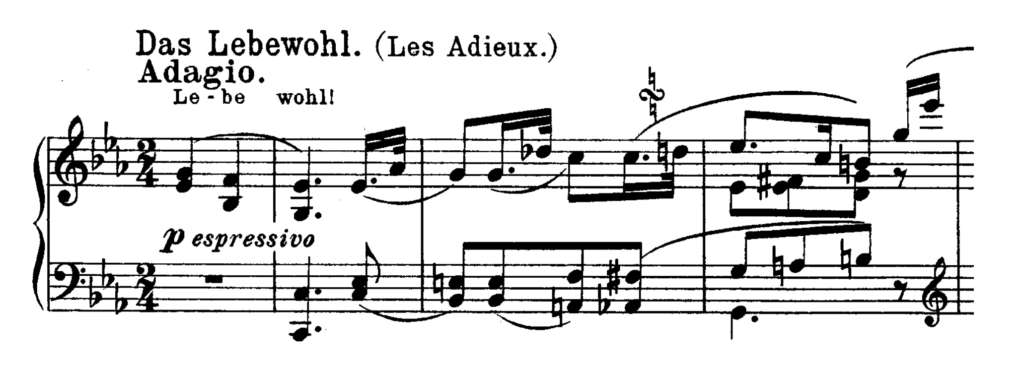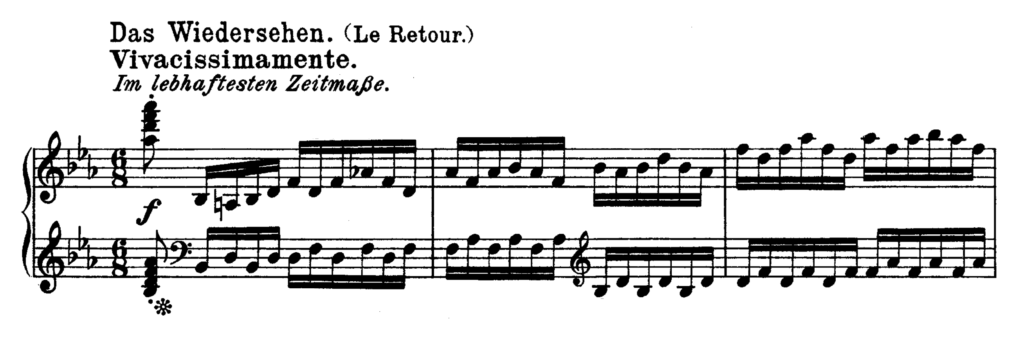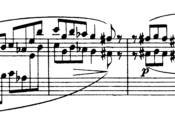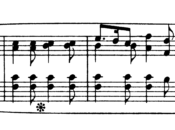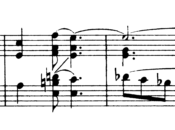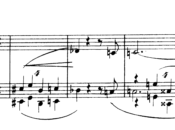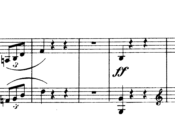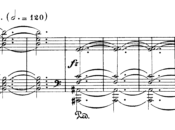Analysis
Contents
For the benefit of all pianists learning this work, we present to you a concise and easy to use analysis of Beethoven’s Piano Sonata No.26 in Eb Major “Das Lebewohl”
First Movement “Das Lebewohl” (Adagio-Allegro)
Form: Sonata Form. Eb Major.
This is the only Piano Sonata to which Beethoven has affixed a title to indicate its contents.
INTRODUCTION:
Bars 1-16: The introduction forms the foundation of a great deal of the succeeding movement, the first three notes (“Le-be-wohl”) especially being used in various forms in the first subject and connecting episode, at the commencement of the second subject, in the development, and in the Coda. The first six bars are repeated, Bars 7-12, slightly altered and transposed.
EXPOSITION:
Bars 1-9: First Subject in E flat major (tonic). The first subject commences upon the subdominant chord, which is followed by a sequence, Bars 1-2, formed upon the “Le-be-wohl” phrase. The figure of the variation of it is evidently taken from Bars 2-3 of the introduction. The “Le-be-wohl” phrase occurs in the bass with the first note dotted, Bars 3-4. These first four bars at first sight seem to be a continuation of the introduction, but they evidently form a part of the first subject, which is in two sections, Bars 1-5 and 5-9.
Bars 9-34: Connecting Episode. The connecting episode begins with a repetition of the second section of the first subject followed by some passages in contrary motion. The “Le-be-wohl” phrase then appears, Bras 19-22, in the bass and (inverted) in the treble, in the same form as in the bass of Bars 3-4; it also occurs in the treble, Bars 30-32, the first note being prolonged. The episode ends with full close in the key of the dominant.
Bars 34-42: Second Subject in B flat major. The second subject being with the “Le-be-wohl” phrase augmented (quadrupled). Bars 34-37 are repeated, Bars 38-41, and octave lower.
Bars 42-49: Coda. The first two bars of the Coda re repeated, Bars 44-45, an octave higher. Bars 46-49 are based upon the “Le-be-wohl” phrase treated in various ways (by diminution in the treble, Bar 46).
Bars 49-55: Bars 49-55 form a passage suggestive of the “Le-be-wohl” phrase, Bars 49-53, leading to the repetition of the exposition, Bars 49-51 and 54-55 leading to the development.
Double bar and repeat.
DEVELOPMENT:
Bars 56-95: The development commences with a reference to the beginning of the first subject, which, with the “Le-be-wohl” phrase, forms the chief material of which it is based.
RECAPITULATION:
Bars 96-104: First Subject in original key. The first subject re-apperas unaltered.
Bars 104-128: Connecting Episode. The connecting episode is of nearly the same length and character as before (Bar 15 being omitted); it is altered to end in tonic key.
Bars 128-136: Second Subject in E flat major (tonic).
Bars 136-End: Coda. The Coda, with the exception of Bars 148-166, which contain a reference to the first subject, is almost entirely based upon the “Le-be-wohl” phrase, which appears in different forms that are easily traceable. In single notes, Bars 167-176; in thirds, Bars 177-181; accompanied by a passage in semiquavers (sixteenth notes), first below and afterwards above it, Bars 183-208; in canon at the octave below, Bars 209-224, diminished, Bars 221-224; and lastly at Bar 229 on inverted pedal point.
Second Movement “Abwesenheit” (Andante Espressivo)
Form: Modified Sonata Form. C Minor.
This movement, though following the outlines of Sonata form, is very irregular.
EXPOSITION:
Bars 1-8: First Subject in G minor and C minor (tonic). The first subject, instead of being in the tonic key, begins with two bars in G minor, followed by two bars in G major, the same four bars are then repeated in C minor (tonic).
Bars 8-14: Connecting Episode. The connecting episode commences in the key of A flat major, modulating to F minor, Bars 9-10. A reference to the first subject in G minor is succeeded by a scale passage leading to the second subject.
Bars 15-19: Second Subject in G major. The second subject, instead of being in the relative major, is in the key of the dominant major.
Bars 19-20: Bars 19-20 lead to the re-entry of the first section.
DEVELOPMENT:
None. There is no development in this movement.
RECAPITULATION:
Bars 21-24: First Subject in F minor. The first subject re-appears in F minor instead of tonic key.
Bars 24-30: Connecting Episode. The connecting episode is similar to the original one, altered so as to end in the key of F major.
Bars 31-35: Second Subject in F major. The second subject, instead of being in the tonic key, re-appears here in F major.
bars 35-42: Bars 35-42 form a passage leading to the next movement, there being no break between the second and third movements.
Third Movement “Das Wiedersehen” (Vivacissimamente)
Form: Sonata Form. Eb Major.
INTRODUCTION:
Bars 1-10: This introduction is entirely formed of arpeggios on dominant harmony.
EXPOSITION:
Bars 11-29: First Subject in E flat major (tonic). The first subject is divided into three sections overlapping each other, and each beginning and ending in tonic key. The first, Bars 11-17, with subject in the treble; the second, Bars 17-23, with subject in the bass accompanied by a new figure in the treble; the third, Bars 23-29, with the subject still in the bass, but with a different accompaniment in the treble.
Bars 29-52: Connecting Episode. The connecting episode begins with florid passages upon tonic pedal point (Bars 29-36). At Bars 36-37 there is a modulation to the dominant. Bars 37-40 constitute a four-bar phrase in G flat major, repeated, Bars 41-44, in F major; Bars 37-44 being repeated, Bars 45-52, with additions and variations. Bars 35-40 and 45-48 in G flat major are evidently formed upon the chord of the Neapolitan sixth in the key of F, the dominant key of the second subject.
Bars 52-81: Second subject in B flat major. The second subject may be divided into four bar phrases throughout. The first phrase, Bars 53-56, is repeated, Bars 61-64, an octave higher. The second phrase, Bars 57-60, is repeated, Bars 65-68, varied and inverted. Bars 69-70 are repeated, Bars 71-72, an octave lower; Bars 73-74 are repeated, Bars 75-76, slightly altered, an octave lower. It ends with a species of Coda of four bars and dominant harmony, in the key of the dominant.
Double bar and repeat from Bar 11.
DEVELOPMENT:
Bars 82-110: The development begins with new material, after which, Bar 95, the second subject appears in B major, first in the bass and then in the treble. At Bar 105 there is a reference to the first subject, leading to its re-appearance.
RECAPITULATION:
Bars 110-123: First subject in original key. The first subject re-appears with a different accompaniment, and on its repetition in the bass, Bars 116-123, the accompaniment is again new (the second repetition is omitted).
Bars 123-146: Connecting Episode. The connecting episode is identical with that in the exposition, altered so as to lead to the tonic key instead of the dominant.
Bars 146-177: Second Subject in E flat major (tonic). The second subject is elongated by two bars (Bars 171-172), otherwise it is literally transposed into tonic key.
Bars 177-End: Coda. The Coda, “Poco Andante,” is formed upon the first subject.

